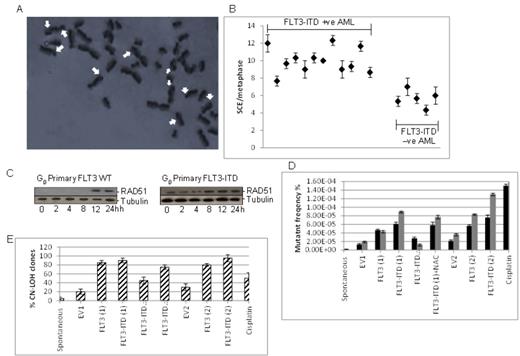Abstract
The majority of patients with adult acute myeloid leukaemia (AML) that present with an apparently normal karyotype (NK-AML) are grouped together in the “intermediate” risk category and constitute 40-45% of all adult AML patients. Mutations in the FMS-like tyrosine kinase 3 (FLT3) receptor whether it is internal tandem duplication (ITD) of its juxtamembrane domain or point mutations in its kinase domain are one of the most common mutations in NK-AML. The presence of FLT3-ITD mutation in NK-AML results in a more aggressive disease, resistance to therapy and poor survival. Acquired copy neutral loss of heterozygosity (CN-LOH) also referred to as uniparental disomy (UPD) is a common phenomenon of myeloid malignancies where an oncogenic allele is duplicated on the other chromosome. The use of single nucleotide phenotype analysis (SNP-A) karyotyping detects CN-LOH in 20% and 40% of newly diagnosed and relapsed AML respectively. CN-LOH at 6p or at the FLT3 locus 13q associated with a FLT3-ITD mutation in NK-AML results in an even more aggressive disease compared to NK-AML + FLT3-ITD without CN-LOH. It has been proposed that CN-LOH is the result of a homologous recombination (HR) DNA repair event. However, the underlying mechanisms that confer CN-LOH have yet to be determined.
To elucidate the mechanisms that produce CN-LOH in NK-AML we determined whether oncogenes such as FLT3-ITD have the propensity to generate CN-LOH through up-regulation of inter chromosomal (between maternal and paternal chromosomes) HR DNA repair. We have showed previously that constitutional FLT3-ITD kinase activity increased reactive oxygen species resulting in elevated double strand breaks. Moreover, FLT3-ITD mutation increases homologous recombination activity through transcriptional augmentation of HR factor, RAD51 expression.
Firstly, to evaluate FLT3-ITD induced genomic instability we measured sister chromatid exchanges (SCE) that result from HR mediated chromosome cross-over. It has been shown previously in the pre-leukaemic chromosomal instability disorder, Blooms syndrome is characterised by increased SCE and an increased propensity for CN-LOH. FLT3/ITD primary AML (n=17), MOLM-13 and FLT3-ITD transfected U937 cells show a significant increase in SCE compared to WT FLT3 primary AML cells, U937 cells transfected with empty vector, (10 vs. 6 SCE per metaphase, p<0.001) (Figure 1A-B). Importantly, primary AML with CN-LOH at 13q + FLT3-ITD mutation gives significantly higher HR activity and SCE than primary AML + FLT3-ITD mutation without CN-LOH (p<0.05). Moreover, treatment of FLT3/ITD primary AML, MOLM-13 and FLT3-ITD transfected U937 cells with the FLT3 inhibitor, CEP701 and the anti-oxidant agent, N-acetyl cysteine restored SCE to levels observed for WT FLT3. Next, we investigated whether inappropriate HR activity at G0 rather than at S phase of the cell cycle could result in illegitimate HR resulting in inter chromosomal HR. Western blot studies showed that G0 primary AML with FLT3/ITD, synchronised G0 MOLM 13 and FLT3-ITD transfected U937 cells showed augmented RAD51 expression compared to non-mutated FLT3 primary AML cells, cell lines and KG-1 transfected with empty vector (Figure 1C). Lastly, we used a thymidine kinase (TK) gene mutation assay system to screen for FLT3-ITD derived CN-LOH. The human lymphoblastoid cell line, TK6 is heterozygous for TK and becomes resistant to trifluorothymidine (TFT) upon loss of the wild type TK allele on 17q. FLT3-ITD transfected TK6 cells (using 2 different expression constructs) demonstrated significantly increased mutation frequency (grey bars) and mutation ate (Black bars) and TFT resistance compared to WT FLT3 and emptor vector control transfection (p<0.001) (Figure 1D). Colony PCR of TFT resistant colonies revealed that resistance was due primarily (80%) to inter chromosomal HR at 17q in contrast to empty vector (20%) and cisplatin treated (45%) TK6 cells (Figure 1E). The findings that FLT3-ITD mutation induces increased ROS production inducing DNA double strand breaks and the concomitant increase in the rad51 dependent inter homologous recombination provide a strong proof of principle that constitutive FLT3-ITD kinase activity directly confers CN-LOH that furthers our understanding of leukaemic progression and relapse in NK-AML.
No relevant conflicts of interest to declare.
Author notes
Asterisk with author names denotes non-ASH members.


This feature is available to Subscribers Only
Sign In or Create an Account Close Modal